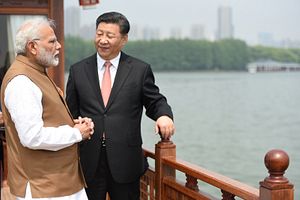While the tenth iteration of the BRICS Summit brought its own share of headlines, an equally notable development was the effort put by Indian Prime Minister Narendra Modi to tour key African states ahead of the meeting alongside Chinese President Xi Jinping’s own visits. The effort spotlighted New Delhi’s continued bid to strengthen its influence in the continent despite the clear limitations it has relative to Beijing.
While India has engaged Africa for long, its capacity to effect changes have been limited primarily due to lack of India’s economic capacity. Conversely, China’s deep pockets and the larger trade engagement have seen it garner far greater influence. Chinese investments in Africa have been growing for more than a decade. In 2014, China-Africa bilateral trade was around $220 billion. In comparison, India-Africa bilateral trade in March 2016-17 was $52 billion.
Modi’s forays to Rwanda and Uganda, before landing in South Africa for the BRICS Summit, was an attempt to bring about new dynamism in the India-Africa relationship. In Rwanda, which has China as its largest trading partner and had inked a strategic partnership with Beijing just last year, Modi became the first Indian leader to visit the country and signed several agreements on trade, agriculture, and defense. In Uganda, Modi delivered the first-ever address for an Indian premier and announced two key lines of credit alongside support for African states across sectors such as agriculture, health, education, infrastructure, defense, and energy sectors.
To be sure, both China and India have downplayed the Sino-Indian rivalry factor in each country’s engagement in Africa. In an effort to downplay the strategic and economic competition in Africa between India and China, the Chinese Foreign Ministry Spokesperson Geng Shuang during a press briefing said that “both China and India are willing to help Africa within the South-South cooperation framework to accelerate its industrialization and achieve self-driven development… China and India are on the same page in this regard.” But even as Chinese officials make such claims, Xi has signed several agreements furthering China’s Belt and Road Initiative (BRI), many components of which has been objected to by India.
Indian officials have similarly echoed Chinese ones in rejecting any competition. TS Tirumurti, a senior official in India’s Ministry of External Affairs, said that the Modi visit was simply a continuation of India’s long relations with Africa, which go “back…to Mahatma Gandhi.”
The reality is much different and also clearer. While New Delhi often makes claims of about its century-old historical relationship with Africa, there can be little doubt that the new Indian focus on Africa is more the result of China’s growing footprint in Africa. China in the last few years has been strengthening its presence and influence in Africa, as well as some of the African littoral states in the Indian Ocean. India’s nervousness with the growing Chinese maritime interests is quite real. In response, India is now trying to step up its cooperation with a number of countries including Seychelles and Mauritius (incidentally, Xi is also included Mauritius in his African tour). The Indian Ocean region along with the littoral states will become much more vital in the coming years, with these maritime spaces carrying two-thirds of the global oil cargo, one third of the bulk cargo, and half of all container traffic.
For New Delhi, Africa has become a lot more significant because of China’s proactive engagement in the region. But at the same time, India’s long neglect and the inadequate economic capacity are serious disadvantages in the face of China’s strategic push and the economic muscle. Nonetheless, India’s promises and commitments will be judged against China’s projects in the region. New Delhi’s biggest challenge has been its inability to deliver on the promises that it makes. There is little sign that India has done much about this, adding to the doubts about India’s capacity to compete with China.
































